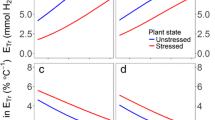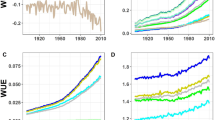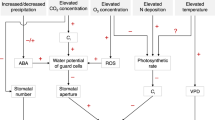Abstract
The ratio of intercellular to ambient CO2 concentrations (c i/c a) plays a key role in ecophysiology, micrometeorology, and global climatic change. However, systematic investigation on c i/c a variation and its determinants are rare. Here, the c i/c a was derived from measuring ecosystem fluxes in an even-aged monoculture of rubber trees (Hevea brasiliensis). We tested whether c i/c a is constant across environmental gradients and if not, which dominant factors control c i/c a variations. Evidence indicates that c i/c a is not a constant. The c i/c a exhibits a clear “V”-shaped diurnal pattern and varies across the environmental gradient. Water vapor pressure deficit (D) is the dominant factor controls over the c i/c a variations. c i/c a consistently decreases with increasing D. c i/c a decreases with square root of D as predicted by the optimal stomatal model. The D-driving single-variable model could simulate c i/c a as well as that of sophisticated model. Many variables function on longer timescales than a daily cycle, such as soil water content, could improve c i/c a model prediction ability. Ecosystem flux can be effectively used to calculate c i/c a and use it to better understand various natural cycles.





Similar content being viewed by others
References
Baldocchi DD (1994) An analytical solution for coupled leaf photosynthesis and stomatal conductance models. Tree Physiol 14:1069–1079
Baldocchi DD (2014) Measuring fluxes of trace gases and energy between ecosystems and the atmosphere: the state and future of the eddy covariance method. Glob Change Biol 20:3600–3609
Ball MC, Critchley C (1982) Photosynthetic response to irradiance by the grey mangrove, Avicennia marina, grown under different light regimes. Plant Physiol 70:1101–1106
Ball JT, Woodrow IE, Berry JA (1987) A model predicting stomatal conductance and its contribution to the control of photosynthesis under different environmental conditions. In: Binggins J (ed) progress in photosynthesis research, vol IV.5. M Nijhoff, Dordrecht, pp 221–224
Blanken PD, Black TA, Yang PC, Neumann HH, Nesic Z, Staebler R, den Hartog G, Novak MD, Lee X (1997) Energy balance and canopy conductance of a boreal aspen forest: partitioning overstory and understory components. J Geophys Res Atmos 102:28915–28927
Brodribb T (1996) Dynamics of changing intercellular CO2 concentration during drought and determination of minimum functional C i. Plant Physiol 111:179–185
Burba G, Anderson D (2010) A brief practical guide to eddy covariance flux measurements. Principles and workflow examples for scientific and industrial applications. LI-Cor Biosciences, Lincoln
Collatz GJ, Ball JT, Grivet C, Berry JA (1991) Physiological and environmental regulation of stomatal conductance, photosynthesis and transpiration: a model that includes a laminar boundary layer. Agric For Meteorol 54:107–136
Cowan IR, Farquhar GD (1977) Stomatal function in relation to leaf metabolism and environment. In: Jennings DH (ed) Integration of activity in the higher plant. Cambridge Unviersity Press, UK, Cambridge, pp 471–505
Damour G, Simonneau T, Cochard H, Urban L (2010) An overview of models of stomatal conductance at the leaf level. Plant Cell Enivon 33:1419–1438
Farquhar DD, Sharkey TD (1982) Stomatal conductance and photosynthesis. Ann Rev Plant Physiol 33:317–345
Farquhar GD, Wong SC (1984) An empirical model of stomatal conductance. Aus J Plant Physiol 11:191–210
Fick A (1855) Ueber diffusion. Ann Phys 170:59–86
Foken T, Wichura B (1996) Tools for quality assessment of surface-based flux measurements. Agric For Meteorol 78:83–105
Jarvis PG (1976) The interpretation of the variations in leaf water potential and stomatal conductance found in canopies in the field. Phil Trans Royal Soc Lond, Ser B 273:593–610
Jarvis PG, Leverenz JW (1983) Productivity of temperate, deciduous and evergreen forests. In: Lange OL, Nobel PS, Osmond CB, Ziegler H (eds) Physiological plant ecology, IV, ecosystem processes: mineral cycling, productivity and man’s influence, 233–280 pp. Springer-Verlag, New York
Katul GG, Ellsworth DS, Lai CT (2000) Modelling assimilation and intercellular CO2 from measured conductance: a synthesis of approaches. Plant Cell Environ 23:1313–1328
Katul GG, Manzoni S, Palmroth S, Oren R (2010) A stomatal optimization theory to describe the effects of atmospheric CO2 on leaf photosynthesis and transpiration. Ann Bot 105:431–442
Keenan TF, Hollinger DY, Bohrer G, Dragoni D, Munder JW, Schmid HP, Richardson AD (2013) Increase in forest water-use efficiency as atmospheric carbon dioxide concentrations rise. Nature 499:324–328
Kelliher FM, Leuning R, Raupach MR, Schulze ED (1995) Maximum conductance for evaporation from global vegetation types. Agric For Meteorol 73:1–16
Landsberg J, Sands P (2011) Physiological ecology of forest production: principles, processes and models. Academic Press, San Diego
Leuning R (1990) Modeling stomatal behavior and photosynthesis of Eucalyptus grandis. Aus J Plant Physiol 17:159–175
Leuning R (1995) A critical appraisal of a combined stomatal-photosynthesis model for C3 plants. Plant Cell Environ 18:339–355
Leuning R, Kelliher FM, De Pury DGG, Schulze ED (1995) Leaf nitrogen, photosynthesis, conductance and transpiration: scaling from leaves to canopies. Plant Cell Environ 18:1183–1200
Lloyd J, Farquhar GD (1994) 13C discrimination during CO2 assimilation by the terrestrial biosphere. Oecologia 99:201–215
Marek M, Pirochtová M (1990) Response of the ratio of intercellular CO2 concentration to ambient CO2 concentration (c i/c a ratio) to basic microclimatological factors in an oak-hornbean forest. Photosynthetica 24:122–129
Medlyn B, Duursma R, Eamus D, Ellsworth D, Prentice C, Barton C, Crous K, Paolo D, Freeman M, Wingate L (2011) Reconciling the optimal and empirical approaches to modelling stomatal conductance. Glob Change Biol 17:2134–2144
Medlyn B, Duursma R, De Kauwe M, Prentice I (2013) The optimal stomatal response to atmospheric CO2 concentration: alternative solutions, alternative interpretations. Agric For Meteorol 182–183:200–203
Mortazavi B, Chanton JP, Prater JL, Oishi AC, Oren R, Katul G (2005) Temporal variability in 13C of respired CO2 in a pine and a hardwood forest subject of similar climatic conditions. Oecologia 142:57–69
Norman JM (1982) Simulation of microclimate. In: Hatfield JL, Thompson I (eds) Biometeorology and integrated pest management. Academic Press, New York, pp 65–99
Novick KA, Oishi AC, Ward E, Siqueira MBS, Juang JY, Stoy PC (2015) On the difference in the net ecosystem exchange of CO2 between deciduous and evergreen forests in the southeastern U.S. Glob Chang Biol 21:827–842
Ryan MG, Law BE (2005) Interpreting, measuring, and modeling soil respiration. Biogeochemistry 73:3–27
Tanner CB, Thurtell GW (1969) Anemoclinometer measurement of Reynolds stress and heat transport in the atmospheric surface layer. Department of Soil Science, University of Wisconsin, Madison, WI, Research and Development Technique Report ECOM-66-G22-F to the US Army Electronics Command, 82
Thomas DS, Eamus D, Bell D (1999) Optimization theory of stomatal behavior I. A critical evaluation of five methods of calculation. J Exp Bot 50:385–392
Tissue DT, Barbour MM, Hunt JE, Turnbull MH, Griffin KL, Walcroft AS, Whitehead D (2006) Spatial and temporal scaling of intercellular CO2 concentration in a temperate rain forest dominated by Dacrydium cupressinum in New Zealand. Plant Cell Environ 29:497–510
Vickers D, Mahrt L (1997) Quality control and flux sampling problems for tower and aircraft data. J Atmos Ocea Technol 14:512–526
Webb EK, Pearman G, Leuning R (1980) Correction of flux measurements for density effects due to heat and water vapor transfer. Quart J Royal Meteorol Socie 106:85–100
Wong SC, Cowan IR, Farquhar GD (1979) Stomatal conductance correlates with photosynthetic capacity. Nature 282:424–426
Wu Z (2013) Carbon balance of the rubber plantation ecosystem in Hainan. PhD dissertation, Hainan University, Hainkou, China
Wu Z, Xie G, Yang C, Chen B, Zhou Z (2015) Characteristics of carbon fluxes in a rubber plantation ecosystem in Danzhou area, Hainan Province. J Northwest Forestry Univ 30:51–59
Wu Z, Chen B, Yang C, Tao Z, Xie G, Zhou Z (2012) Distribution of footprint and fluxes source area of rubber plantation in Hainan Island. J Tropical Organ 3:42–50
Wu Z, Chen J, Lan G, Chen B, Xie G, Zhou Z (2013) Quality assessment of turbulence data in rubber plantation ecosystem. Chin J Trop Crops 34:2075–2082
Xiao JF, Sun G, Chen J, Chen H, Chen S, Dong G, Gao S, Guo H, Guo J, Han S, Kato T, Li Y, Lin G, Lu W, Ma M, McNulty S, Shao C, Wang X, Xie X, Zhang X, Zhang Z, Zhao B, Zhou G, Zhou J (2013) Carbon fluxes, evapotranspiration, and water use efficiency of terrestrial ecosystems in China. Agric For Meteorol 182–183:76–90
Zhang H, Nobel PS (1996) Dependency of c i/c a and leaf transpiration efficiency on the vapor pressure deficit. Aus J Plant Physiol 23:561–568
Acknowledgements
Data of this paper is available by sending e-mail to site principal investigator (wzxrri@163.com). This work was supported by the National Natural Science Foundation of China (31200347, 31660142) and Youth Innovation Promotion Association of Chinese Academy of Sciences.
Author information
Authors and Affiliations
Corresponding author
Rights and permissions
About this article
Cite this article
Tan, ZH., Wu, ZX., Hughes, A.C. et al. On the ratio of intercellular to ambient CO2 (c i/c a) derived from ecosystem flux. Int J Biometeorol 61, 2059–2071 (2017). https://doi.org/10.1007/s00484-017-1403-4
Received:
Revised:
Accepted:
Published:
Issue Date:
DOI: https://doi.org/10.1007/s00484-017-1403-4




